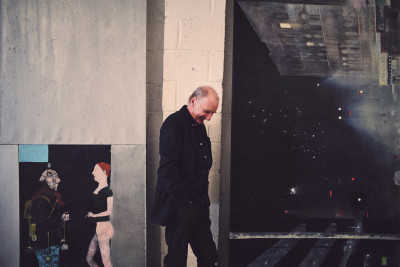10 minutes with… Frank Bowling RA
10 minutes with… Frank Bowling RA
By Amy Macpherson
Published 22 September 2014
Each month, we have a quick chat with one of our Academicians to find out what they’re up to and what the RA means to them.
-
Originally from Guyana, Frank Bowling RA graduated from the Royal College of Art in 1962. His early work was figurative but he moved towards abstraction from the late 1960s onwards, and is renowned for his large-scale paintings saturated with colour. He has lived and worked on both sides of the Atlantic, with studios in London and New York, and in 2005 became the first black artist to be elected a Royal Academician. We visited him at home in Pimlico, where he lives with his wife, the textile artist Rachel Scott.
What are you working on at the moment?
I’m revisiting a lot of the ways of working that I have used over my career - at the moment I’m vacillating between making small paintings and big paintings like the ones that I had in this year’s Summer Exhibition [Across the Wadi, pictured below]. I’ve had to pare back my activities because my body is older now than when I first started [making large-scale paintings]. At 80, even though I can still lift a palette loaded up with paint, and spill and drip, and use spatulas and palette knives and brushes, I tire. I was advised not to work for more than two hours a day, but that’s never really enough. I tend to do two shifts – two hours in the morning and two in the afternoon.
I work on a trestle table and recently I’ve had to have various younger, stronger people helping to deliver the paint material onto the surface, because I can’t stand up for very long. It’s getting better because I’ve been seeing a lot of quacks… We’re going this afternoon to see the osteopath because he’s trying to do something about my back and my neck. So I get help, and that encourages me to make these big paintings.
Currently our friend Rose Jones is completing her film on my work and career, and she’s in the studio filming everything so there are many more people in the studio than when I started out. I’m also preparing for a show that’s opening in Sweden in October – yesterday I did a phone interview with a Swedish magazine.
-

Frank Bowling RA, Across the Wadi.
Featured in the Summer Exhibition 2014..
Acrylic. 267 x 186 cm. Photo: Jon Bodkin/DawkinsColour.
-
What is your earliest memory of art?
In about 1953 or 54, I met a marvellous man called Keith Critchlow when we were both doing national service [in the RAF]. He had gone to art school and was a very good draughtsman, and he decided to paint my portrait.
He introduced me to the museums and galleries. We used to visit galleries in Cork Street and then go to the National Gallery, the Tate – which is now Tate Britain – and I was very struck by the British painters like Constable, Turner and Gainsborough, whose marvellous touch I was very engaged by. And the painters who were around at the time: Leon Kossof, Frank Auerbach, people like that, I felt a kind of affinity with. I was very keen on writing because I kept hearing from people that I had a story to tell… But once I started visiting the art galleries, I got hooked on painting.
It was just a kind of happenstance, and what was amazing about Keith was that during the time he was having me sit for him, he caught onto the fact that I was fascinated by painting and was doing it on the sly by myself without tuition. So he got a big mirror and he used it to show me what he was doing.
How do you know when a work is finished?
Well I often don’t – I often depend on Rachel to tell me when to stop!
The canvas comes in a certain size, three metres. I work on part of it, cut it, keep trying to deliver the material onto the surface… When it’s covered all over and there’s no more adjusting and tightening up the tonalities, often at that point I stop and eyeball the thing and decide on the shape.
When I was working just simply by myself, the actual shape of the canvas would be dictated by geometry, by measuring the angles, and of course by the space I was working in, my studio space. But now there’s not quite as much to-ing and fro-ing and cutting and putting together again. Eventually the surface is saturated with the material until it’s sort of ‘giving back’. Then you know that it’s done. Suddenly the painting is looking like your estimation of what you were trying to do.
When did you find out you’d been elected an RA?
Michael Sandle RA approached me one evening at some soiree in the Tate gallery, and asked me if I wanted be an Academician. There had been several attempts to get me in from about 1966, and it never seemed to happen. But then suddenly out of the blue, this very nice man and gifted sculptor asked me would I like to be put forward again, and I said yes. It was 2005 and we were in New York, and out of the blue he rang up one day and announced that I’d got in. I was overjoyed.
-

Frank Bowling RA, Wintergreens, 1986.
Acrylic on canvas. 1740 x 3480 x 100 mm. Photo: RA/John Hammond © Royal Academy of Arts, London.
-
What does the RA mean to you?
The RA means an awful lot of things to me. It’s obviously a wonderful institution, it’s hundreds of years old and has got that kind of authority. It’s singular in its tradition in our society and our culture.
During my student years, people like [Royal Academicians] Carel Weight and Roger de Grey and Rodney Burn would encourage me to send in to the Summer Exhibition, and when I graduated I continued to do that. I got a lot of support from people who were teaching at the Royal College who were Academicians.
When I was living in New York and making those big ‘Map Paintings’, I kept coming back to see my two sons who were living in London at the time. At one point Carel Weight arranged for me to be able to work on those paintings in one of the big rooms in the Academy. Nice things like that have happened. I was invited to participate in a big show called 25 Years of British Painting [in 1976], and I’ve been invited to go and teach in the Schools.
If you were president for the day what would you change?
I wouldn’t like to be president, you know – not even for a day! The current president is absolutely marvellous in how he handles things. I don’t have that sort of social skill. On occasions where I would erupt and raise my voice, he’s so even - smoothing over the bumps. It’s a special quality that someone like the President of the Royal Academy has to have. It’s an august institution and it has amazing responsibilities.
Traingone: Paintings by Frank Bowling 1979–96, which includes his Royal Academy diploma work Wintergreens, pictured above, is at the Spritmuseum in Stockholm from 23 October 2014 – 6 April 2015.





